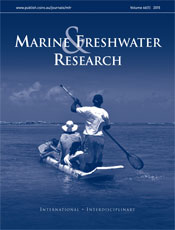Marine and Freshwater Research
Volume 66
Number 1 2015
The homing and orientation skills of Palinurus elephas were investigated in order to inform future marine reserve design. Homing ability seemed to be constrained to where lobsters were only displaced a short distance. Our data suggest that it will be important that any restocking of reserves must be performed with lobsters collected in adjacent zones at a distance of more than 0.5 km away becauselobsters collected within 0.5 km will return their original place.
Fish living among dense aquatic plants are often difficult to sample with traditional methodologies, leading to knowledge gaps of habitats important for aquatic conservation. This study developed underwater video techniques that successfully estimated fish population sizes within dense, invasive aquatic plant habitats. This new methodology allows monitoring programs to quantify fish habitat use and population sizes within complex habitats, such as invasive aquatic plants.
Tourism in natural areas often affects animal communities as a result of the short-term behaviour (avoidance or attraction) of sensitive species toward humans. In a coral reef, we showed that tourism led to persistently fewer species than in control reefs, while only few human-tolerant species thrived along with high tourism. Thus, short and long-term effects may affect reef-fish communities exposed to intense tourism pressures.
This study investigated the population growth rates of Cichla ocellaris, a non-native species in the Upper Paraná River floodplain, Brazil. The lower growth rate estimated for the Paraná River population could have been associated with stronger density-dependent influences. C. ocellaris of the Baía and Ivinheima Rivers appear to be less influenced by density-dependent factors given their more recent invasions of those areas.
Baseline ecological studies are important to inform the management of temperate estuaries. We describe patterns in the abundance and size structure of large bivalves inhabiting shallow sand habitats in a permanently open estuary. While bivalves are probably important in the trophic ecology of this system and are potential indicators of disturbance and ecosystem health, we highlight that effective management also requires knowledge of natural processes and anthropogenic pressures.
Adverse impacts of acidification on aquatic biota have been observed worldwide; however, most reports are based on anthropogenically acidified fresh waters rather than naturally acidic systems. This study aimed to investigate the effect of decreased pH on macroinvertebrate and fish communities within naturally acidic (wallum) streams. The results provide support for the reduced importance of acidity in naturally acidic waters.
The impacts of heavy rainfall on ecosystems are important to understand, since it has frequently occurred in recent years. In the present study, we sought to understand the succession of phytoplankton species, before and after extremely heavy rain, in a subtropical lagoon. After heavy precipitation, a phytoplankton bloom dominated by Chaetoceros curvisetus (99.3%) occurred. Overall, our results suggest that the bloom succession of phytoplankton species was principally dependent on nutrient dynamics in the lagoon, which was associated with nutrients discharged from drainage after heavy rainfall.
Ageing using otolith microstructure is based on the assumption that growth increments are deposited daily. Here, we analysed the otolith microstructure of the glacier lanternfish (Bentosema glaciale) and we concluded that microincrement counting should not be directly used to infer the true age of Age-class 1 fish in the Flemish Cap. Alternative methods for ageing this species should be explored.
It is important to understand the population dynamics of myctophids for a better understanding of the functioning of the ecosystem. Here, age-based demographic parameters of glacier lanternfish (Benthosema glaciale) from the Flemish Cap were calculated to estimate ages from counts of annuli in the whole otolith. Because myctophids are considered opportunistic strategists, changes in their demographic features may reflect shifts in the ecosystem.
Unique morphological characteristics and habitat selection of intertidal invertebrates may influence their ability to cope with thermal stress. We deployed biomimetic temperature loggers for three interacting species and found microhabitat variability produced greater differences in body temperatures than differences due to morphological characteristics. This highlights the role of thermal refugia in mitigating the effects of climate change on rocky intertidal shores.




